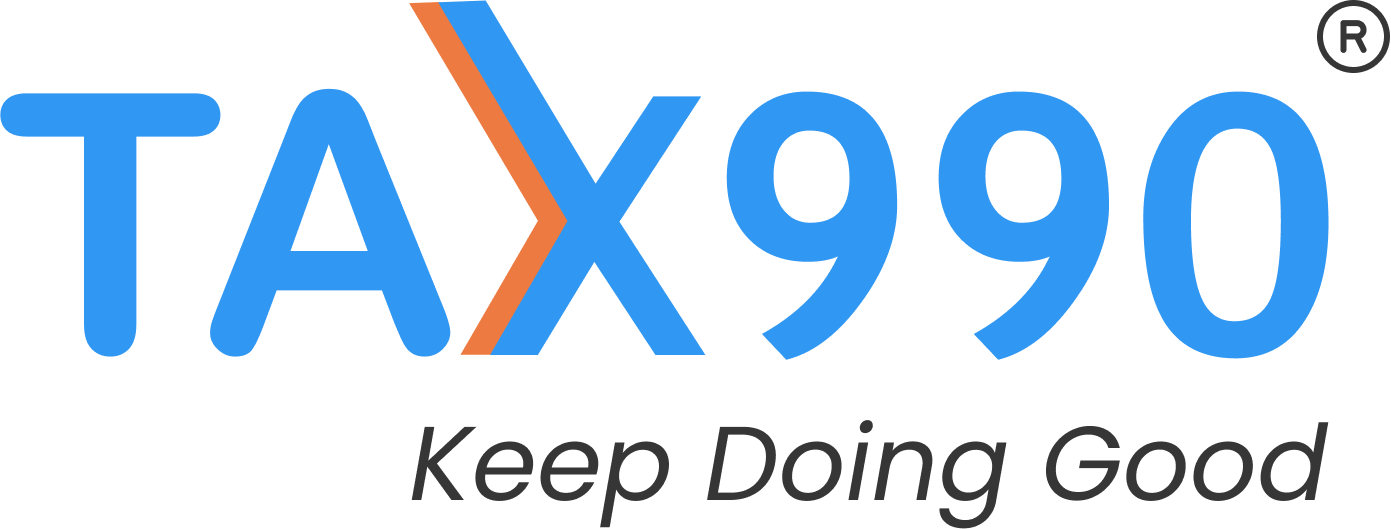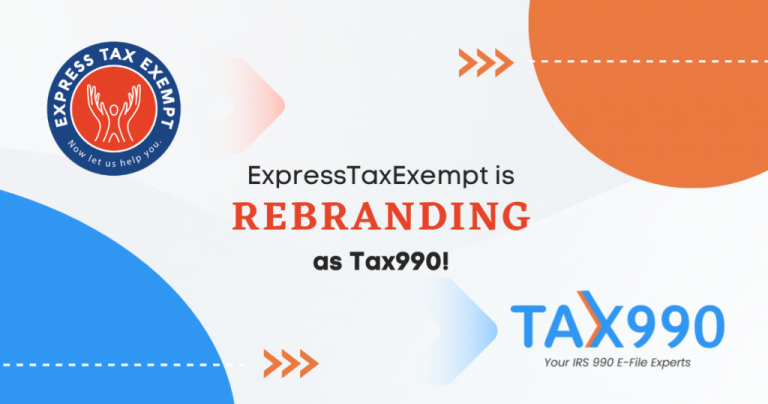Form 990-PF E-Filing Instructions for Nonprofit Organizations
Estimated reading time: 31 minute(s)

Form 990-PF is a nonprofit tax return used by private foundations to report revenue, expenses, direct charitable activities, capital gains and losses, officer details, distributions, and activities to the IRS. Private foundations must file Form 990-PF annually or face penalties of $20 per day up to a maximum of $10,000 or 5% of the foundation’s gross receipts.
Form 990-PF has 16 parts requiring different information. Keep reading for a breakdown of the entire form, part by part.
Basic Information
First, you’ll need to provide
- Start and end dates of the tax year
- Name and address of the organization
Then, lettered boxes ask for more information
- Box A: Employer Identification Number (EIN)
- Box B: Telephone number
- Box C: Check if your foundation’s exempt status is pending
- Box D: Check for foreign organizations
- Box E: Check for private foundations terminated under section 507(b)(1)(A)
- Box F: Check for foundations in a 60-month termination under 507(b)(1)(B)
- Box G: Type or purpose of return (initial return, final return, address change, initial return of a former public charity, amended return, name change)
- Box H: Type of organization (Section 501(c)(3) exempt private foundation, section 4947(a)(1) non exempt charitable trust, other taxable private foundation)
- Box J: Accounting method (cash or accrual)
- Box I: Fair market value of all assets at the end of the year
Part I: Analysis of Revenue and Expense
- Lines 1-12 (Revenue)
-
-
- Lines 1-11: Enter the value of contributions, gifts, interest on savings, dividends, interest from securities, gross rents, net rental income, capital gain net income, net short-term capital gain, income modifications, gross sales less returns, allowances, and other incomes
- Line 12: Enter teh total revenue by adding Lines 1-11
-
- Lines 13-26 (Operating and Administractive Expenses)
-
- Lines 13-23: Enter the employee salaries and wages for the year, compensation given to officers, directors, and trustees, pension plans, employee benefits, travel expenses, conferences, and meetings.
- Line 24: Enter the total operating and administrative expenses by adding lines 13-23
- Line 25: Enter the contributions, gifts, and grants paid
- Line 26: Enter the total expenses and disbursements by adding lines 24 & 25
- Line 27: Enter excess of revenue over expenses and disbursements, net investment income, and the adjusted net income
Part II: Balance Sheet
- Lines 1-16 (Assets)
-
-
- Lines 1-15: Enter details about cash-non-interest-bearing, savings, and temporary cash investments, grants receivable, prepaid expenses and deferred charges investments and other assets. Value at the beginning and end of the year must be reported.
- Line 16: Enter the value of total assets
-
- Lines 17-23 (Liabilities)
-
-
- Lines 17-22: Enter liability details such as deferred revenue, grants payable, loans from officers, directors, trustees, and other disqualified persons
- Line 23: Enter the value of total liabilities by adding lines 17-22.
-
- Lines 24-30 (Net Assets or Fund Balances)
-
- Lines 24-28: Enter the asset or fund balance details such as net assets without donor restrictions, net assets with donor restrictions, capital stock, trust principal, current funds and retained earnings, accumulated income, endowment, and any other funds
- Line 29: Enter the total net assets or fund balances
- Line 30: Enter the total liabilities and net assets/fund balances
Part III: Analysis of Changes in Net Assets or Fund Balances
- Lines 1-6: Report the changes in your organization’s net assets by calculating the difference between the value of net assets or fund balances at the beginning and end of the year
Part IV: Capital Gains and Losses for Tax on Investment Income
- Line 1: Enter the kinds of property sold, if it was purchased or donated, the date acquired, date sold, the gross sales price, depreciation allowed, cost or other basis plus the expense of the sale, and if it was a gain or a loss.
- Line 2: Enter the capital gain net income or capital loss
- Line 3: Enter the net short-term capital gain or loss as defined in sections 1222(5) and (6)
Part V: Excise Tax Based on Investment Income (only applicable to the private foundations described under Sections 4940(a), 4940(b), or 4948)
- Line 1: Exempt operating foundations described under section 4940(d)(2) are required to check the box and enter “N/A”
- Lines 2-4 (Section 4947(a)(1) trusts and taxable foundations only): Enter the tax under section 511 and Subtitle A (income) tax
- Lines 5-11: Enter the tax based on the investment income, any penalty for underpayment of estimated tax, and tax due and overpayment
Part VI-A: Statements Regarding Activities
- Lines 1-16: Answer the “yes” or “no” questions regarding your foundation’s political activities and expenditures, unrelated business income, substantial contributors, and a few other details
- Lines 2-4 (Section 4947(a)(1) trusts and taxable foundations only): Enter the tax under section 511 and Subtitle A income tax
- Lines 5-11: Enter the tax based on investment income, any penalty for underpayment of estimated tax, and tax due and overpayment
Part VI-B: Statements Regarding Activities for Which Form 4720 May Be Required
- Lines 1-8: Answer the “yes” or “no” questions about your foundation’s activities. Any foundation that answers “yes” to any of the questions in this part should file Form 4720.
Part VII: Information About Officers, Directors, Trustees, Foundation Managers, Highly Paid Employees, and Contractors
- Line 1: Enter the foundation’s officers and employees’ names and addresses, titles and average hours per week, compensations, contributions to employee benefit plans and deferred compensation, and the expense account and other allowances
- Line 2: Enter the compensation amounts of the five highest-paid employees (other than those included in line 1). If none, enter “none”
- Line 3: Provide details about five of the highest-paid independent contractors for professional services
Part VIII-A: Summary of Direct Charitable Activities
- Enter a summary of the charitable activities, events, and expenses made during the tax year, including relevant statistical information such as the number of organizations and other beneficiaries served, conferences convened, research papers written, or other activities should be included here
Part VIII-B: Summary of Program-Related Investments
- Lines 1 & 2: Enter two of your foundation’s major program-related investments made during the tax year
- Line 3: If your foundation makes any other program-related investments, enter them here
Part IX: Minimum Investment Return
- Line 1: List out the fair market value of assets not used directly in carrying out charitable purposes, average monthly cash balances, and FMV of all other assets.
- Line 2: Enter the application indebtedness of the assets mentioned on Line 1
- Lines 3 & 4: Determine and enter the cash deemed held for charitable activities
- Lines 5 & 6: Using the above information, the net value of noncharitable-use assets and minimum investment return can be derived and reported
Part X: Distributable Amount (Section 4942(j)(3) and (j)(5) private operating foundations and certain foreign organizations do not need to complete this part)
- Lines 1-7: Report the monetary amount for the tax year that your foundation must distribute by the end of 2022 as qualifying distributions to avoid the 30% tax on the undistributed portion
Part XI: Qualifying Distributions
- Line 1a: Enter expenses, contributions, gifts, etc.
- Line 1b: Enter the program-related investments
- Line 2: Enter the amounts paid to acquire assets used or held for carrying out charitable activities
- Line 3: Enter the amounts set aside for specific charitable projects that satisfy the Suitability test and cash distribution test
- Line 4: Using the above information, qualifying distributions can be derived and reported here
Part XII: Undistributed Income (non-operating foundations must complete this part)
- Lines 1-10
-
- Reduce any undistributed income from prior years
- The organization may use any part of or all remaining qualifying distributions for 2022 to satisfy elections
- If no elections are involved, apply the remaining qualifying distributions to the 2022 distributable amount on Line 4d
- If the remaining qualifying distributions are greater than the 2022 distributable amount, the excess is treated as a distribution out of corpus on Line 4e
- Enter the amount of excess distributions carryover, for the five prior tax years
Part XIII: Private Operating Foundations
- Line 1a: Enter your foundation’s ruling or determination date if received and under what section the foundation is described
- Line 1b: Check if your foundation is a private operating foundation described in section 4942(j)(3) or 4942(j)(5)
- Line 2: Enter the lesser of the adjusted net income or the minimum investment return for each year listed and provide details about the qualifying distributions
- Line 3: Enter details about the alternative test relied upon. “Assets” alternative test, “endowment” alternative test, “Support” alternative test
Part XIV: Supplementary Information (complete only if your foundation had $5,000 or more in assets)
- Line 1: Provide information regarding foundation managers
- Line 2: Provide information regarding contributions, grants, gifts, loans, scholarships, and programs
- Line 3: Enter details about the grants and contributions paid during the year or approved for future payment
Part XV-A: Analysis of Income-Producing Activities
- Lines 1-13: Enter details about program service revenue, membership dues and assessments, dividends and interest from securities
Part XV-B: Relationship of Activities to the Accomplishment of Exempt Purposes
- This part requires an explanation of how each activity for which income is reported in Part XV-A contributed importantly to the accomplishment of the foundation’s exempt purposes
Part XVI: Information Regarding Transfers To and Transactions and Relationships with Noncharitable Exempt Organizations
- Line 1: Enter “Yes” if your foundation engaged in any transfers or transactions with any other organization described in section 501(c) (other than section 501(c)(3) organizations) or section 527 political organizations
- Line 1a: Enter “yes” if your foundation engaged in transfers with a noncharitable exempt organization of cash or other assets
- Line 1b: Enter “yes” if your foundation engaged in transactions with a noncharitable exempt organization of sales of assets to a noncharitable exempt organization, purchases of assets from a noncharitable exempt organization, rental of facilities, equipment, or other assets, loans or loan guarantees, or performance of services or membership or fundraising solicitations
- Line C: Enter “yes” if your foundation is engaged in the sharing of facilities, equipment, mailing lists, other assets, or paid employees
- Line 1d: If you have answered “yes” to any of the above, provide more information on those details
- Line 2: Enter “yes” if your foundation is affiliated with any tax-exempt organizations described in section 501(c) and elaborate on the details in the table.
Signature:
In this section, officers such as the president, vice president, treasurer or assistant treasurer, chief accounting officer, or others can sign and approve the form. A receiver, trustee, or assignee must sign any return that they are required to file for a corporation. If filed for a trust, the authorized trustee(s) must sign. Paid preparers can also sign here.
E-filing with Tax990
Although Form 990-PF is fairly lengthy, Tax990 makes e-filing simple. Countless features including free Schedules, an internal audit check, and two different form preparation methods allow clients to file efficiently.
Tax990 has an informative website full of blogs, YouTube videos, FAQs, and more to help guide and inform clients every step of the way. If anything goes wrong, our customer support team is available via phone, email, and chat from Monday through Friday 8:30 AM – 5:30 PM EST.
Don’t hesitate to e-file your tax-exempt returns. Get started today at tax990.com.


